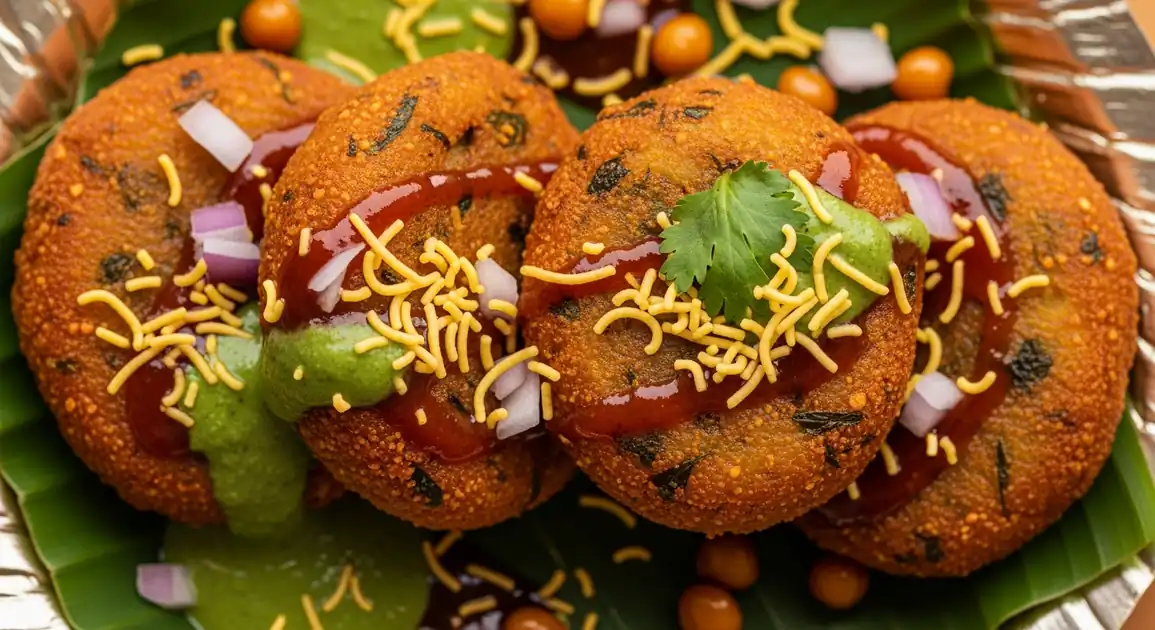Aloo Tikki (Potato Patties)
आलू टिक्की

Description
Aloo Tikki is a ubiquitous street food found throughout North India, with regional variations in serving style and accompanying chutneys. From the crowded lanes of Old Delhi to the modern street food complexes in metropolitan cities, Aloo Tikki represents the perfect affordable comfort food that's enjoyed by people across all social strata.
Dietary Information
Serving information
Serving style
Typically served on small disposable plates or dona (leaf bowls), eaten with small wooden or plastic spoons. Always served hot with chutneys applied on top or on the side.
Quick facts
Most vendors operate from 12 PM - 9 PM, with peak hours in the evening from 5 PM - 8 PM.
Safety Tips
What to Look For
-
Patties fried thoroughly until golden-brown on both sides
Proper cooking ensures food safety by reaching temperatures that kill harmful bacteria. Undercooked pale tikkis may contain unsafe bacteria.
-
Hot, actively sizzling griddle (tawa)
A properly heated cooking surface ensures the tikkis cook thoroughly and crisp up properly.
-
Fresh chutneys that look vibrant
Fresh green chutney should be bright green, not brown or discolored, indicating it was prepared recently.
-
Covered ingredients and clean preparation area
Ingredients should be protected from flies and dust. The vendor's station should appear organized and relatively clean.
-
High customer turnover
Popular stalls typically serve fresher food as they prepare ingredients more frequently throughout the day.
What to avoid
-
Pre-fried tikkis sitting at room temperature
Tikkis should be fried fresh to order. Pre-fried patties sitting out can harbor bacteria, especially when topped with yogurt and chutneys.
-
Pale or undercooked patties
Tikkis should be golden-brown and crisp, not pale or soft, ensuring they've been cooked to food-safe temperatures.
-
Uncovered or visibly spoiled chutneys and yogurt
Dairy products and wet chutneys are particularly prone to spoilage in warm weather. They should look fresh and be stored properly.
-
Vendors who handle money and food without washing hands
Cross-contamination can introduce harmful bacteria. Good vendors use separate people for handling money or wash hands between tasks.
-
Reused oil that appears very dark or smells rancid
Quality vendors change their cooking oil regularly. Very dark, smoky oil can indicate poor practices and affect both safety and taste.
Price information
Price range
Budget tips
- Standard street vendors charge 20-40 INR for a basic plate.
- Market stalls and food courts typically charge 30-60 INR.
- Restaurant or upscale versions can cost 80-100 INR.
- For best value, look for vendors outside colleges and office areas who offer generous portions.
Value indicators
- Freshly fried in front of you.
- Generous portion size (usually 2-3 tikkis per plate).
- Homemade chutneys rather than bottled.
- Complimentary extras like extra chutney or sev.
- Crispy exterior with properly cooked interior.
Where to Find This Dish
Urban Markets
Concentrated in traditional shopping areas and local markets.
Neighborhood bazaars, Weekly haats (markets)
Evening
Educational Institutions
Popular outside schools, colleges, and universities.
College gates, School surrounding areas
Afternoon, Evening
Office Complexes
Found in business districts catering to office-goers.
Office building surroundings, IT parks
Lunch hours, Evening
Vendor Tips
- Many vendors have their own 'special' recipe - ask locals for recommendations.
- Request 'garam garam' (hot hot) to ensure you get freshly fried tikki.
- For extra crispy tikkis, ask them to fry it 'kadak' (extra crisp).
How to Order
Regional Variations
-
Plain Aloo Tikki
(सादा आलू टिक्की)
The basic version featuring only the fried potato patty with minimal toppings, usually just the two chutneys.
-
Aloo Tikki Chaat
(आलू टिक्की चाट)
A more elaborate version where the tikki is topped with yogurt, both chutneys, chopped onions, sev (crispy chickpea noodles), and chaat masala.
-
Dahi Aloo Tikki
(दही आलू टिक्की)
Focuses on generous amounts of whisked yogurt topped over the tikki, along with chutneys and spices.
-
Ragda Patties
(रगड़ा पेटीस)
A Mumbai variation where the tikki is served with ragda (a white pea curry), topped with chutneys and onions.
-
Stuffed Aloo Tikki
(भरवां आलू टिक्की)
Features a filling inside the potato patty, typically of spiced peas, paneer (cottage cheese), or mixed vegetables.
-
Aloo Tikki Burger
(आलू टिक्की बर्गर)
A modern fusion where the tikki serves as a burger patty between buns, often with Indian-style sauces and toppings.
Cultural context
History
Aloo Tikki has its roots in North Indian cuisine, particularly in Delhi and the Punjab region. The word 'tikki' comes from the Sanskrit 'tukkā' meaning small pieces. While potato patties have been part of Indian cuisine for centuries, the modern street food version evolved in the bustling lanes of Old Delhi, where vendors perfected the art of creating crispy exteriors while maintaining soft, flavorful interiors. It represents India's ingenious use of affordable ingredients to create deeply satisfying food accessible to all.
Local significance
Aloo Tikki represents India's vibrant street food culture and the art of creating flavorful, satisfying dishes from simple ingredients. It's a great equalizer - enjoyed by people from all walks of life.
Eating customs
- Eaten hot and fresh directly at the stall.
- Customarily consumed with both mint and tamarind chutneys.
- Often paired with a cup of hot chai (tea).